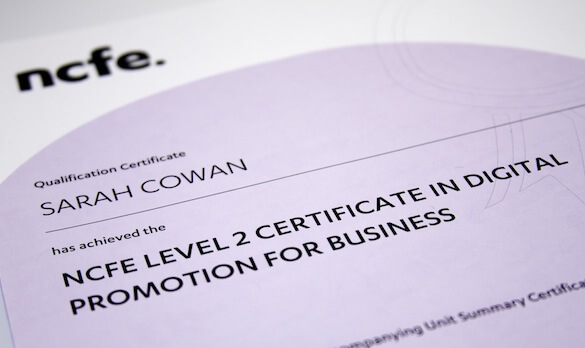
Is traditional marketing dead?
Friday 30 March 2018
I was awarded the NCFE Level Two Certificate in Digital Promotion for Business

Friday 30 March 2018
I was awarded the NCFE Level Two Certificate in Digital Promotion for Business
Anyone who is familiar with my work will know that I am a great believer in the continued power of print. There are many reasons for this – the authority of words committed to ink on paper, the tactile nature of a printed piece of marketing, the physical reminder that print creates, and so on. So when I saw an online advert proclaiming that ‘traditional marketing is dead’ my interest was piqued.
What I had found, in fact, was an advert for an online course called Digital Promotion for Business. Designed by members of the Chartered Institute of Marketing and accredited by NCFE, the course is intended to help ‘tackle the digital skills crisis’ – a shortfall of 745,000 digitally-skilled workers in the UK alone.
The eight modules are free to undertake at your own pace over ten to twelve weeks. I signed up, completed all eight modules, and earlier this year I was awarded my NCFE Level Two Certificate in Digital Promotion for Business, reducing the shortfall to 744,999!
We began with a primer on the marketing basics. But even before the end of the first module, ‘conventional media’ and printed materials were woven through the four stages of the sales process model – Awareness, Comprehension, Conviction, and Action.
Conventional adverts are still useful for raising awareness of a product or service – you only need to look at glossy magazines to know that large brands still plough a lot of money into them. But when it comes to communicating more detailed information explaining the features and benefits of a product or service, or convincing potential customers to make a purchase, then printed brochures come into their own. You often see this process in action in the car industry, but it is a pattern which is often repeated in other markets which sell high-value products and services.
It begins with those full-page adverts in traditional media such as newspapers and magazines which include little information at all but nevertheless persuade us that our lives would be so much better if only we had such a beautiful car.
These adverts often point us to a website for more information, but how many people buy a car directly from a website at this stage? More likely, people who are interested will request a brochure, or pick one up from a showroom when they go for a test drive. They want to know all the facts about the car – the top speed, the likely MPG, whether it will fit in their garage, what the emission are, the various trim options, pricing, and so on. And they want to look at all this away from the eagle eyes of the salesmen in the garage, somewhere they can compare it with another brand of car as well.
Of course, digital marketing techniques are employed alongside the ‘traditional marketing’ in this process, and they have undeniable benefits too. Digital marketing is fast. It can be updated almost instantly to respond to a new product or a change in price or availability. It can also be personalized, so it is only shown to a particular group of people or people in a particular location. It’s two-way, so potential customers can respond just as quickly, and compared to traditional advertising, channels like social media are undeniably inexpensive.
But now that so many businesses are using digital media, the marketplace is getting crowded. How many marketing emails do you receive each day? And how many do you delete without opening? Do the increasing number of adverts on search engine results and social media irritate you? And, as a business, how much time do you spend creating digital content, and then responding to the dialogue it creates?
Over eight modules it was clear that the most effective use of digital marketing is in conjunction with traditional marketing. There are some things that each does well, so it’s key to know which tool (digital or traditional) to use in each instance, and how to combine them to maximum effect. But it is also very clear that traditional marketing is far from dead. It remains a core part of marketing products and services – particularly those with a higher price tag – and to ignore it is to miss out.
If you would like to complete the Digital Promotions for Business course yourself, you’ll find more information on the Digital Skills Scotland website.
Recent posts
Featured posts

Hello! I’m Sarah, an independent typographic designer, helping businesses to communicate their unique selling points through printed marketing and communications.
I’ve been sharing my knowledge about design, typography, marketing, branding and printing since 2014. I hope you enjoy reading my blog.

Sarah Cowan